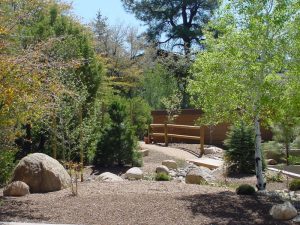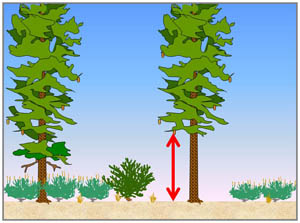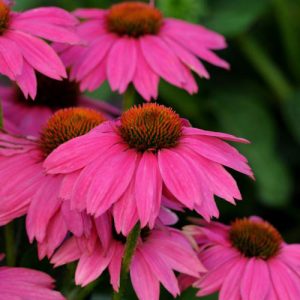 Residents new to the mountains are seeking solitude and escape from the rat race. They want some of the services of urban living but they also want to live near the forest to get “back to nature”. Locally we call this the urban-wildland interface. Many who are new to the woodland lifestyle often are unaware that it comes with some risks. As we saw this past week, the primary hazard is the danger from wildfire.
Residents new to the mountains are seeking solitude and escape from the rat race. They want some of the services of urban living but they also want to live near the forest to get “back to nature”. Locally we call this the urban-wildland interface. Many who are new to the woodland lifestyle often are unaware that it comes with some risks. As we saw this past week, the primary hazard is the danger from wildfire.
Gardeners new to wildfire awareness can be cautious to the extreme. Many tend to fall in love with their chainsaws, cut down most plants in their yards, and then spread ‘em over with rocks! As a diehard gardener I take the middle ground on firewise landscaping. My years of wildfire training and teaching support the notion that landscapes can be safe, sane, and pretty. I believe that it’s possible to have a woodland landscape design that is both beautiful and safe.
The top priority of a fire-dissuading landscape is to create a “defendable space”, that is, an area that will serve as a buffer zone should fire approach that home. The goal is to keep a fire moving “slow and low” until it can be extinguished. Some plants are more flammable than others, so, especially if really close to the house, these varieties should be kept thinned. This simple strategy will keep fire “low” to the ground and moving “slow”.
Evergreen conifers are high in resins and waxes, the properties that keep them evergreen and durable; unfortunately, they also are highly combustible substances. Closest to the house it is wise to reduce the number of juniper, pine, spruce, and cedar. Each of these varieties, high in plant resins, will burn easily. Replace them with deciduous plants, that is, plants that lose their leaves in winter. Deciduous plants retain more water in their foliage, which makes them much more difficult to ignite and burn. They also drop their foliage during the cool months. If shed leaves are left on the ground they dry into a significant amount of combustible material. Picking up and discarding freshly fallen leaves removes a source of ignition from the yard.
Water and feed any landscape to keep its denizens healthy. During summer water your existing natives once per month until the monsoons arrive. Ornamental landscape plants appreciate a deep soak once each week. A layer of composted mulch is money well spent; it helps suppress weeds and keeps moisture around healthy plants, which is especially helpful in June.
 Avoid “ladder fuels”. An example of this scenario is a dry grass that ignites a taller shrub that catches the pine trees on fire, and then jumps to the roof. Remember, our goal with a firewise landscape is to keep a fire on the ground, out of trees’ canopies, and off the roof. Ideally, design garden islands in the yard with an interesting plant mix separated from the next garden island by a driveway, patio or rock lawn. This firewise technique allows firefighters some precious space between gardens should they have to fight flames.
Avoid “ladder fuels”. An example of this scenario is a dry grass that ignites a taller shrub that catches the pine trees on fire, and then jumps to the roof. Remember, our goal with a firewise landscape is to keep a fire on the ground, out of trees’ canopies, and off the roof. Ideally, design garden islands in the yard with an interesting plant mix separated from the next garden island by a driveway, patio or rock lawn. This firewise technique allows firefighters some precious space between gardens should they have to fight flames.
Clean debris from gutters and roof. Needles and leaves on the roof and in gutters provide tinder for blowing sparks. Chip piles of brush for use as compost or completely remove it from your landscape.
~~ ~~ ~~ ~~ ~~ ~~ ~~
 Fire wise plants can be very pretty and as wildly striking as this week’s pictured Pow Wow Wildberry Echinacea. This ruby toned beauty produces a floriferous flurry of huge 4-inch wide raspberry hued flowers with dark centers. Very difficult to ignite in a wildfire, this outstanding new variety is the winner of the garden acclaimed AAS award. It won the ribbon ‘by the skin of her petals’ for continual bloom right through summer’s heat and into fall. This full-bodied, strong branching, 20-inch tall plant requires little deadheading and only modest upkeep. It is proof that it is possible to have a pretty, firewise garden that blooms summer through fall.
Fire wise plants can be very pretty and as wildly striking as this week’s pictured Pow Wow Wildberry Echinacea. This ruby toned beauty produces a floriferous flurry of huge 4-inch wide raspberry hued flowers with dark centers. Very difficult to ignite in a wildfire, this outstanding new variety is the winner of the garden acclaimed AAS award. It won the ribbon ‘by the skin of her petals’ for continual bloom right through summer’s heat and into fall. This full-bodied, strong branching, 20-inch tall plant requires little deadheading and only modest upkeep. It is proof that it is possible to have a pretty, firewise garden that blooms summer through fall.
Characteristics of a firewise plant are fivefold:
- Supple leaves
- Water-like sap
- Thick bark
- High moisture content
- Low resin content (like the Pow Wow Wildberry Echinacea)
There is not enough space in this column for additional plant suggestions, but there are many more choices. I have composed a list of firewise landscape plants. Entitled, “Planting a Firewise Landscape”, it is free for the asking.
~~ ~~ ~~ ~~ ~~ ~~ ~~
The right landscape design is critical when planting in the urban-wildland interface. Creating a firewise balance between existing trees, and evergreens is tricky. It’s too easy to get it wrong. With this in mind, I have called in a favor from a landscape design buddy of mine, Rich Olsen. Rich is a master designer and really knows how to create designs that are firewise.
 Rich has agreed to work for free every Friday to help local gardeners figure our how to make their landscapes safe. He will be glad to look at a digital photo of your landscape and suggest firewise modifications. As he only will be at our garden center on Fridays from 9-3pm, you may email a garden photo to him at [email protected]. We have to love generous people who actually care enough about their communities to contribute freely of their skills. 🙂 Once you’ve had a taste of his work I’m certain that your thanks will join with my thanks to Rich.
Rich has agreed to work for free every Friday to help local gardeners figure our how to make their landscapes safe. He will be glad to look at a digital photo of your landscape and suggest firewise modifications. As he only will be at our garden center on Fridays from 9-3pm, you may email a garden photo to him at [email protected]. We have to love generous people who actually care enough about their communities to contribute freely of their skills. 🙂 Once you’ve had a taste of his work I’m certain that your thanks will join with my thanks to Rich.
Until next week, I’ll see you in the garden center.


I can’t thank you enough for this valuable information. This is not something I would have even thought of a few months ago. Bless you!